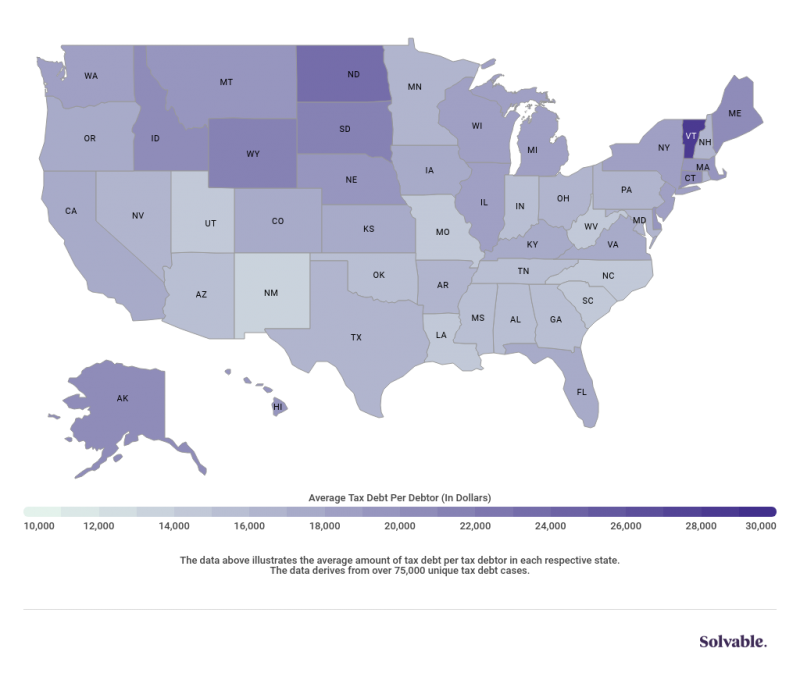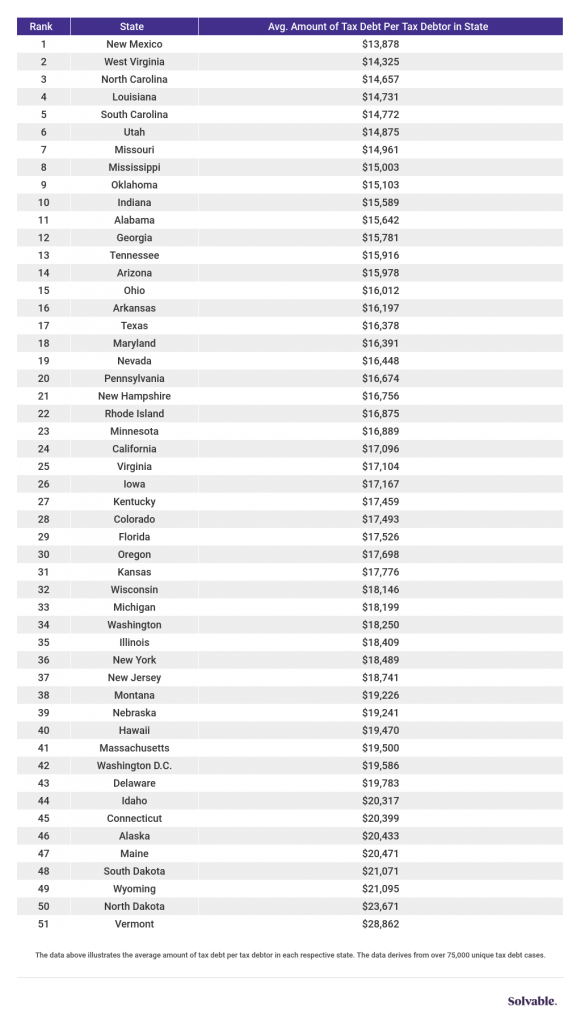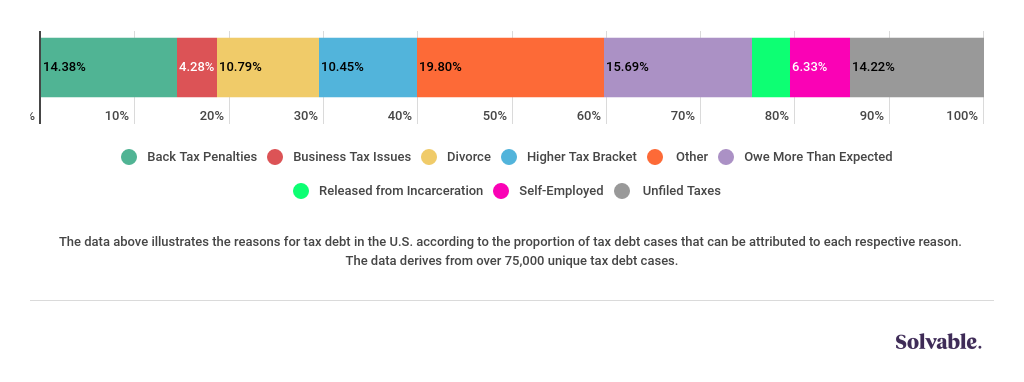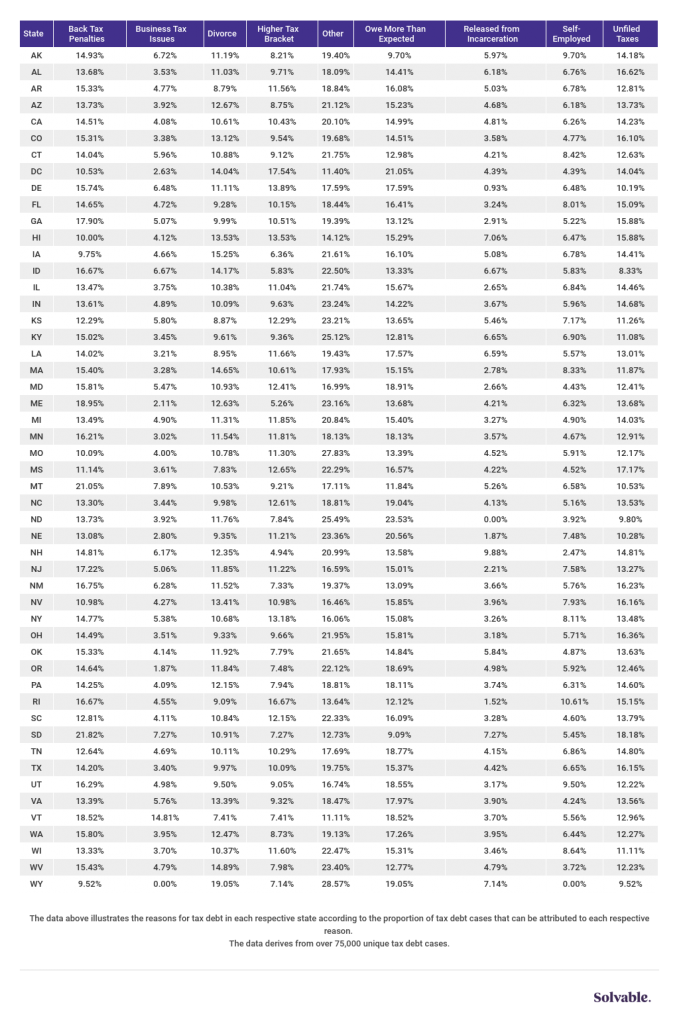At Solvable, we care about your financial well-being and are here to help. Our research, articles and ratings, and assessments are based strict editorial integrity. Our company gets compensated by partners who appear on our website. Here is See More
Last Updated on
While obligations related to mortgages, student loans, and credit cards grabs headlines, another class of debt often goes unnoticed, despite significant accumulation: back taxes.
Tax delinquency impacts a significant portion of United States taxpayers. The Internal Revenue Service (IRS) reported that at the end of fiscal year 2018 there were 13.1 million delinquent taxpayer accounts. Given the rapid expansion of the gig economy, like ride-share drivers, freelancers, or other 1099 contractors, we expect this delinquent number will grow.
A September 2019 IRS report pegged the national tax gap, or the difference between federal taxes owed and paid, for 2011 to 2013 (the most recent, fully analyzed years available) at $441 billion. After the IRS recovered $60 billion through enforcement efforts and late payments, the net tax gap amounted to $381 billion.
Accounting for state taxes, the total tax gap figure for federal and state back taxes is an estimated $527 billion.


The consequences of back taxes can be severe, including things like wage garnishment, asset seizure, and international travel restrictions. Yet the significant amount of back taxes across the U.S. seems to fly under the radar. We teamed up with LendEDU to analyze data from more than 75,000 cases of back taxes.
See More >> This Guy Resolved His $8,597 Tax Debt - Learn His Methods!
Using this dataset, we found the average amount of back taxes per tax debtor for each of the 50 states and Washington, D.C., in addition to the nationwide average. We also outlined the most common reasons people go into back taxes in each state.
All data in this report was provided exclusively to LendEDU. Our data includes more than 75,000 cases of back taxes from Solvable customers. LendEDU completed all calculations.
Tax debtors in New Mexico have the lowest average of owed back taxes: $13,878.
Trailing close behind New Mexico are:
These and 16 other states fall below the national average back taxes of $16,849.
The remaining 29 states and Washington, D.C., each post average back taxes above the national average. Vermont registered the highest average back taxes per tax debtor: $28,862. That’s $14,984 higher than New Mexico’s and $5,191 higher than the next highest average back taxes, North Dakota at $23,671.
See More >> How One Woman Crushed $300,000+ of Student Loan & Mortgage Debt


Most states in the Northeast corridor, an area of the U.S. known for high taxes and a high cost of living, had back taxes above the national average. These states included:
States in the Midwest and West also posted average back taxes figures on the higher end of the spectrum:


In another regional trend, Southern states showed a propensity for low average back taxes, with 10 states in this region falling below the national average. This included:
See More >> Trustworthy Tax Relief Companies + Customer Reviews
The most common stated reasons for tax debt on a national scale included:
The same back tax trends that apply to the U.S. as a whole also hold true at the state level.


South Dakota could attribute 21.82% of its back taxes cases to owed taxes accumulated due to “back tax penalties,” followed by:
North Dakota (23.53%) led the way in back taxes brought on by “owing more than expected,” trailed by:
“Unfiled taxes” accounted for 18.18% of back taxes cases in South Dakota, followed by:
See More >> Jen Paid Off $42,000 in Credit Card & Medical Debt...
Finally, 19.05% of back taxes cases in Wyoming were due to “divorce,” trailed by:


Most back taxes are composed of unpaid individual and corporate income taxes; followed by back taxes from employment, estate, and excise taxes. The IRS attributes the tax gap mainly to taxpayers who understate the amount of taxes they owe on timely filed tax returns, but also includes taxpayers who file tax returns late, and those who both file and pay late.
Generally, both the IRS and state tax agencies are willing to negotiate a tax settlement with a tax debtor for a portion of the money owed.
If you are unable to pay the full balance due after crunching your taxes for 2019, here are five steps to seek assistance and avoid severe consequences.
Filing an extension with the IRS can buy you six more months to get your personal finances in order to save the money you need to pay your tax bill. The IRS extension for 2020 will give you until Oct. 15 to file your tax return.
See More >> I Paid off $150,000 of Debt - How I Did It!
You can use this time to find part-time work by joining the gig economy like millions of others on Uber, Lyft, TaskRabbit, and DoorDash to save enough to pay your balance in full.
The IRS offers a payment plan called a “long-term installment agreement” for those who can’t pay their balance due in full within 120 days, as long as you owe less than $50,000, including penalties and interest.
To qualify, you must meet specific criteria, and the monthly payments you propose must pay off your entire back taxes, including interest and penalties, within three years.
If you are unable to make minimum payments to pay off your back taxes within three years, you may qualify for an Offer in Compromise, an IRS program that reduces your tax liability. You must meet certain criteria based on your expenses, income, assets, and amount owed.
While your account is in “Currently Not Collectible” status, the IRS agrees neither to collect your taxes owed, nor seize your assets or income. Your back taxes will still collect interest and penalties, and the IRS will likely apply tax refunds you earn during this period to your taxes owed.
“Innocent spouse” assistance from the IRS could relieve you of responsibility for paying taxes, interest, and penalties if your spouse (or former spouse) improperly filed a joint tax return without your knowledge.
All data that can be found within this report was anonymized and provided exclusively to LendEDU for analysis. The dataset comprised 75,330 unique cases of back taxes. The back tax cases reflect a date range from March 1, 2019 to August 31, 2019.
Included in the dataset were things like the amount of back taxes for each unique case, the reason for that back taxes, and the state where the tax debtor was from.
The total national back taxes figure (combined federal and state back taxes) is an estimate. There is no citable figure that reports the cumulative state back taxes, so the figure in here of $146 billion must only be treated as a rough estimate.
** The total national back taxes figure of $527 billion that can be seen towards the top of this report is an estimate. While the federal back taxes figure of $441 billion is data provided by the IRS, there is no exact report on cumulative back taxes from state-based taxes. Solvable conservatively estimates that figure to be roughly around $146 billion. This estimate was found by extrapolating California’s reported 2018 tax gap figure that was between $20 and $25 billion to the rest of the U.S. states. Adding the estimated state-level tax gap to the net federal tax gap of $381 billion makes a total estimated tax gap of $527 billion.